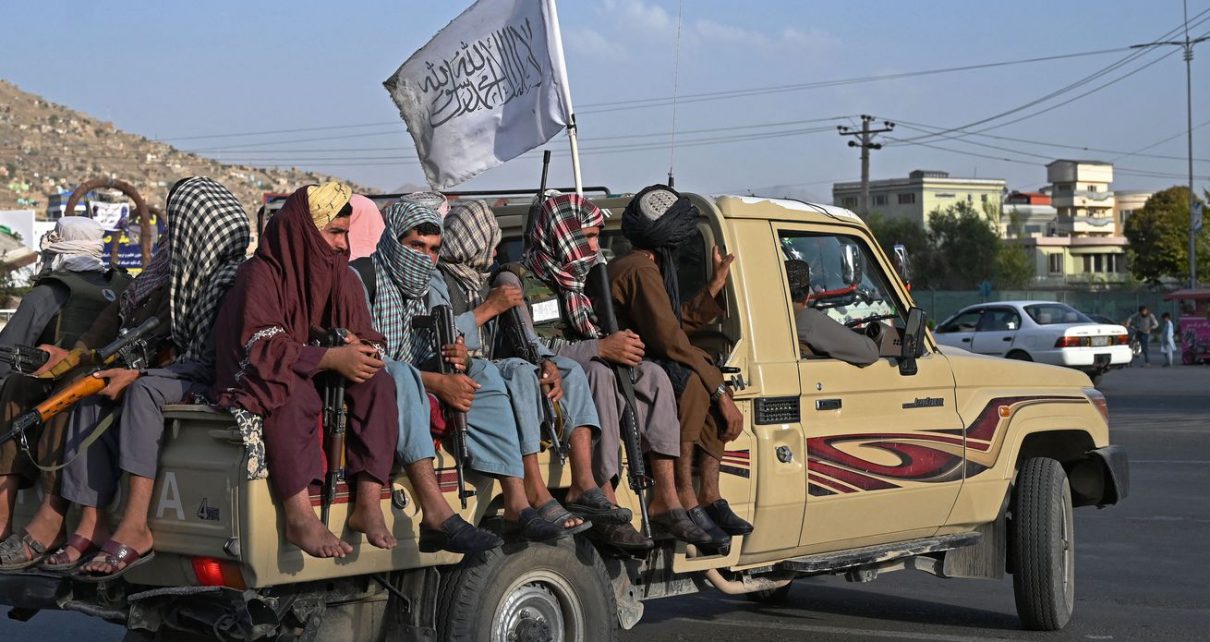
Their willingness to work with former enemies, commitment to distributing aid, and treatment of women will be strong tests of their purported moderacy.
The biggest question since the Taliban recaptured Kabul on August 15 has been whether the group’s return to power means the same thing for Afghans that it did 25 years ago.
The last time the Taliban controlled all of Afghanistan, from 1996 to 2001, was marked by brutal oppression, particularly of minorities and women. Their proclivity for violence, which continued throughout their post-9/11 resurgence as an insurgent force, has resulted in civilian massacres, human trafficking, and an environment dictated by fear.
But since announcing the Islamic Emirate of Afghanistan, the group’s leaders have downplayed that history, saying they have evolved with the times.
In the group’s first press conference, Taliban spokesperson Zabihullah Mujahid promised amnesty for Afghans, that women would have rights “within Islamic law,” and that the group’s days of harboring terrorists are over. Mujahid has been astute about optics as well — a TV interview with a Taliban official was anchored by a woman journalist.
So which version is more likely to be true? Taliban rule is still in its early days, but experts say there are several indicators that observers can look to — the group’s willingness to power-share in a government, proactiveness in distributing aid, and treatment of women — to suss out how they might rule.
Right now it’s not just the Taliban’s history that’s in direct contradiction to the moderation they are outwardly projecting, experts say. It’s their current behaviors, too — including violent crackdowns of protests and door-to-door manhunts for people on their blacklist.
“It’s a charm offensive on one side and a terrorist offensive on the other side,” said Rina Amiri, a senior fellow at New York University’s Center on International Cooperation.
Will the Taliban share power?
When the Taliban took over Kabul in 1996, the city’s infrastructure was battered and its population of several hundred thousand people, traumatized by a decade of civil war, had no expectation of government services or facilities. The Kabul of today, by contrast, has nearly 4.5 million people, who are used to being able to participate in democracy, demonstrate, receive schooling, access health care, and connect with the rest of the world. To be sure, over the past 20 years, the democratically elected government and the sectors of the economy flush with foreign aid experienced a lot of corruption. But the country did urbanize; the economy did grow.
While the Taliban have recent experience ruling mostly rural provinces, city governance is an entirely different task.
“Only [having] experience in shooting guns is not going to work if you are expecting a peacetime environment where you are responsible to provide your people with public services in an orderly way,” said Sher Jan Ahmadzai, the director of the Center for Afghanistan Studies at the University of Nebraska Omaha. “And this is a challenge for the Taliban to lead.”
So one of the first things experts are looking at is whether the Taliban can commit to working with former enemies, including members of the deposed democratically elected government, and actually enforce the amnesty policy they claim to support.
Those decisions are still in motion, Ahmadzai said. There has been some level of outreach to former President Hamid Karzai and former Afghan peace delegation leader Abdullah Abdullah, who have sought to be mediators.
“They’re thinking of how to rule, who to bring into the government, and how they can coax previous people from previous governments back into this system,” Ahmadzai said.
William Nomikos, a professor of political science at Washington University in St. Louis who studies violent extremism and civil wars, said a truly moderate, modernized Taliban would be willing to make concessions in order to effectively run the country.
“The real distinguishing mark between a rebel force that takes control but is really trying to be a government is, are they willing to make concessions to former adversaries,” Nomikos said. “Are they willing to establish a formal power-sharing agreement?”
Ahmadzai said that would require incentivizing people to want to work with the Taliban. But so far, they have allegedly targeted some of those who worked with the US. The mere fact that tens of thousands of Afghans are risking their lives to get to Kabul International Airport and onto flights speaks to their fear, at least, that the Taliban’s ability to work with former enemies is nonexistent.
#Taliban spox says the Taliban are no longer allowing Afghan nationals to go to #Kabul airport because of the chaotic situation there. He said the US had kept on inviting people to the airport to board planes. “Don’t encourage Afghans to leave.We need their talent.” Via @BBCWorld
— Bel Trew (@Beltrew) August 24, 2021
“Government is not done by force, and cannot be done by force,” he said. “It’s going to be a huge challenge for the Taliban. Government is not easy. It is not fun. It is not as easy as destruction.”
Can the Taliban deliver food and water aid to its population?
Another indicator experts plan to follow is monitoring how the Taliban handle Afghanistan’s emerging food and water scarcity crises.
With foreign governments and NGOs alike pulling aid so as to not empower the Taliban, the group will have to figure out if they want to provide services that give people the ability to see a doctor and other necessities. And they’ll have to do it while navigating a burgeoning economic crisis and a severe drought across the country that is expected to severely impact farmers’ and herders’ ability to provide food.
Estimates in June from the International Rescue Committee found that 80 percent of Afghans rely on agriculture and cattle-grazing for their incomes, which requires rain. The scarcity crises have begun in earnest, with 40 percent of the IRC’s survey respondents already experiencing negative impacts from a lack of water.
Even before the drought, estimates from the US Agency for International Development in 2020 found that 8.2 million Afghans need emergency food assistance, and 11 million can be classified as food-insecure.
“If the electricity fails, that’s a real problem,” said Thomas Barfield, president of the American Institute of Afghanistan Studies. “Food is a real problem. Afghanistan has suffered from a drought. You’ve got to feed the population.”
Food aid was primarily the job of NGOs and is quickly drying up. Attempts from the Taliban, or lack thereof, to re-secure or provide that aid will be an important signal to experts about their interest in helping their population.
International aid is vital to that task, but that would require recognition from foreign governments, which could provide some food or water aid. China, which has both business and security interests in Afghanistan, has been floated as a potential source of legitimacy. The Taliban could make a deal with China to allow them access to minerals in Afghanistan in exchange for some level of aid, Barfield said.
But China, with concerns about how to protect its engineers and policy of giving infrastructural rather than humanitarian aid, as it does with Pakistan, could be reticent to provide actual material help, Barfield added. Another signal that the Taliban are serious about feeding the population could be allowing in the United Nations — but that would require a serious compromise of their anti-Western ideology.
The hunger situation was so dire in the 1990s that, in a rare moment of pragmatism prevailing over ideology, the Taliban did allow the United Nations World Food Program into Kabul. At the time, a quarter of Kabul residents received bread from the UN or the Red Cross. Barfield said a similar allowance today would be an acknowledgment from the Taliban that providing basic aid to Afghans is a priority.
“They need the cooperation of the outside world,” he said. “No Afghan government can stay in power if it allows its people to starve.”
How is the Taliban already treating women?
Finally, the most critical indicator of whether the Taliban’s rhetoric is real or just lip service to the international community will be the group’s treatment of women.
The US-led military intervention over the past 20 years has a complicated legacy when it comes to women’s rights, as Vox’s Jen Kirby detailed. But over the past two decades, women have gone to school, become part of the workforce, and held positions of power in the government.
Reports already exist of the Taliban returning to their harsh past, with women in provinces the Taliban captured in months and years past being forced out of their jobs, and once again being required to have a male relative accompany them outside the house.
Experts are watching to see what women already are and are not allowed to do.
“Will there be women in government?” Nomikos said. “Will there be women in positions of power? Will women be allowed to go to university, to go to school?”
Amiri said that the Taliban are already providing an answer. Her contacts on the ground say that as the Taliban have taken over different provinces, they are showing up with lists of women activists, journalists, and government collaborators to systematically harass and intimidate their families.
Continuing those practices would be a clear sign that the Taliban are prioritizing ideology over pragmatism. Excluding women from society would also be indicative of a Taliban that is not interested in concessions for the sake of governance or in keeping its population afloat.
“Kabul, particularly, couldn’t function if they said no women could work,” Barfield said. “Let’s watch. Schools are going to be opening; offices are going to be opening. They’re going to have to make some decisions, and we’re actually going to be able to see.
“There’s women doctors,” he continued. “There’s people who know how to run the electrical system, the water system. You’ve got to come to some kind of modus operandi with these people, because if the system collapses, you’re sort of responsible.”
Failure to compromise could spell trouble for the Taliban
As Kirby explained, there are real pressures on the Taliban to be more pragmatic; some level of international legitimacy is needed in order to gain access to the aid that the state depends on. But right now, Ahmadzai said the Taliban’s behavior indicates the creation of a security state, where the military functionally dictates society — no matter what they are saying publicly.
“There might be some development work, nominally, but behind the scenes, [it could likely] be a security state that would be suppressing the rights of women and human beings, suppressing condemnations of the system, and not letting people criticize,” Ahmadzai said.
But maintaining that depends on military monopolization of control. Within days of the Taliban reentering Kabul, Afghans were already protesting, raising the government flag, and openly defying Taliban rule — not just in Kabul but in Jalalabad and Khost as well.
Experts said armed resistance to the Taliban over the coming months is possible, too, particularly given the weaponry that warlords and their militias have, depending on how the Taliban proceed.
“This time, you’re coming into the most open and progressive period in Afghan history, and you’re going to shut that down,” Amiri said. “I don’t think that’ll go over very well.”
There are Afghans, particularly in rural areas, who might support or at least sympathize with Taliban ideology and be wary of running afoul of such a dangerous group. Additionally, the Taliban were able to get this far through cutting deals with warlords — a lesson they learned from their failures in 2001. But if the Taliban pursue devastating policies, and people lose access to the grants that allowed them to pursue livelihoods or the aid that kept them alive, those deals could be off, their support could wither, and the country could descend into civil war, Nomikos said.
The Taliban must decide over the next several months, as the US leaves for good and international aid is diverted, if they actually intend to pursue pragmatism. Their level of commitment to amnesty in governance, aid, and women’s rights will be indicators of their decisions. And a failure to adapt could lead to their destruction.
“The Taliban have never shown the capacity to govern, so how are you going to manage the expectations of the people?” Amiri said. “If you’re oppressive, and you [also] can’t deliver basic services and goods, that’s not going to work.”
But experts also cautioned against underestimating the Taliban’s ability to rule purely by force and fear — that very miscalculation has undermined the US’s efforts at every turn.





